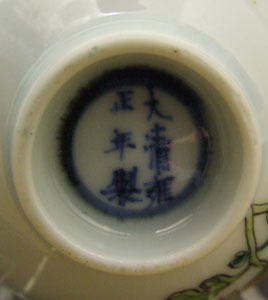
YONGZHENG 1723 – 1735 Six Character Mark and of the Period
A Finely Painted Yongzheng Famille Rose Cup, Six Character Yongzheng Mark and of the Period 1723-1735. Decorated in the Chinese Taste with Chrysanthemum and Peony.
SOLD
- Condition
- Perfect.
- Size
- Diameter : 6.25 cm (2 1/2 inches).
- Provenance
- N/A
- Stock number
- 22880
Information
While this cup bares the six character mark of Yongzheng and is of the period, it is unlikely to have been made by Imperial command.
Famille Rose Porcelain :
China`s ceramics industry has for thousands of years be connected to events in the world outside it`s own borders. Importing materials, assimilating foreign ideas, foreign tastes and inventions, as well as making ceramics for cultures completely foreign to it`s own tastes and ethos China has always adapted it`s ceramics industry to fit the needs of it clients who ever they may be. It was during the Qing dynasty, especially from the late 17th century, that the Chinese became especially interested in Western technology and science. Famille Rose enamels were developed as a consequence of this interaction, the Chinese referred to these enamel colours as foreign colours from as early as 1734 but there origin can be traced back to the 1720`s if not earlier. The impetus for the development of this new palette was the direct involvement emperor Kangxi (1662-1722) who desired to improve expertise in the manufacture of all crafts, especially in relation to learning about technology from abroad. Famille Rose enamels were different to the earlier Famille Verte enamels in a number of ways, the most obvious being the colours used, but the enamels themselves were different in that the translucent colours of the earlier palette were making way to thicker impasto opaque enamels of Famille Rose. The rose colour that gives its name to this colour scheme is created from colloidal gold (a suspension or colloid of sub-micrometre-sized particles of gold in a fluid). This ruby red colour was augmented by two other newly introduced coloured enamels, an opaque white which was made from fine crystals of lead arsenate, the other new colouring agent was lead stannate used for the opaque yellow. These colours, while new to China, were certainly not new to Europe but the effect of them on porcelain certainly was new. Famille Rose didn`t entirely replace Famille Verte as such but it certainly became far more popular. Famille Rose enamel was used in the Imperial workshops to paint some of the most complex intricate designs ever carried out on Chinese porcelain, it was also used for Chinese taste or domestic market porcelain, but was also used to decorate a vast array of Chinese export porcelain of all shapes and sizes.
Peony :
Peonies are the most commonly encountered flower on Chinese porcelain, indeed in Chinese art in general. There are two cultivated types of peony commonly depicted, the tree peony Paeonia Suffruicosa (Mudan) and the herbaceous peony P.Lactiflora (Shaoyao). Both have rich exuberant flowers with thin silk like petals but the plants are rather different to each other. The tree peony is not in fact a tree but a deciduous shrub, sometimes rather large and sprawling, it has irregular woody stems. It shares a similar leaf and flower form to the herbaceous peony but they are not close in other ways. The Chinese refer to the peony as the `King of flowers` and are seen as equivalent to the first rank among officials. The flowers are closely associated with royalty because they have been grown in imperial gardens since the Sui dynasty (581-618). The peony is one of the flowers of the four seasons and represents the Spring. It symbolizes wealth and honour, honour in the sense of high rank, having an official position, or high social status.
Plum Blossom / Meihua :
Plum (Prunus), Meihua, is one of the most important plants in Chinese art. Their flowers grow on knurled old angular branches, the flowers are fragile and pure, so they can be a symbol of vigour in old age as well as purity. The tree is the first to flower after the long hard winter, symbolically it can represent perseverance as well as renewal. This meaning is enhanced by a background of cracked-ice, the design can be seen as representing the end of winter and the beginning of spring with the ice of winter cracking to reveal a new year dawning. Branches of plum blossom convey the `Five Blessings` Meikai wufu, longevity, wealth, health, love of virtue and a peaceful death. The number five, an auspicious number to the Chinese, is taken from the five petals of the plum flower.


